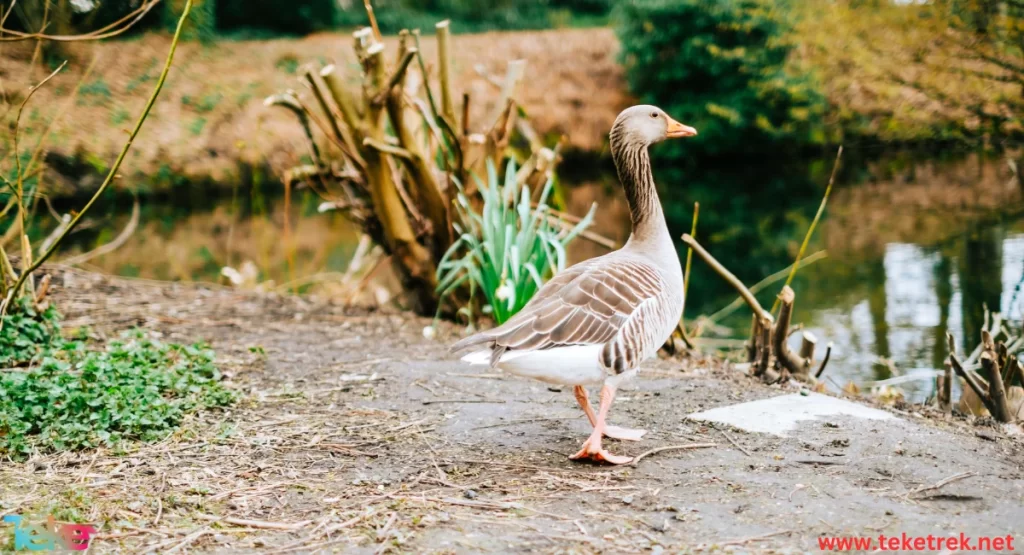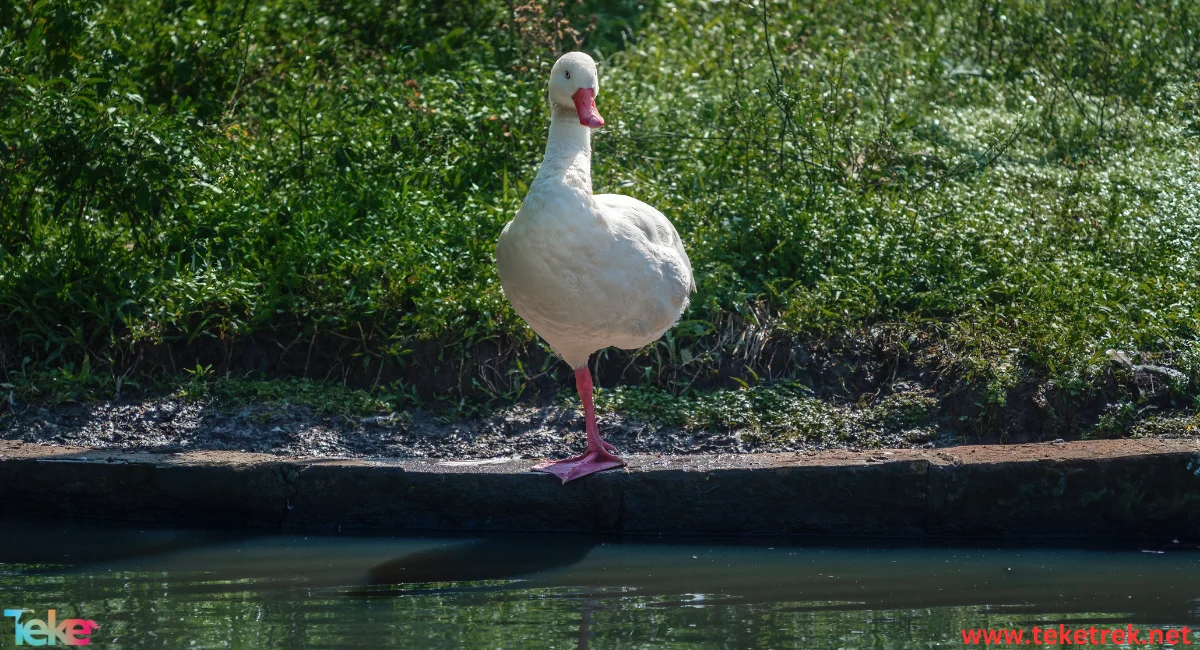The goose, a beautiful bird characterized by its pride and dignity. Therefore, it always keeps its head held high as if it were a queen, graceful in its steps. It is considered the mistress of poultry, as humans have been accustomed to breeding it since ancient times. It is known for its elegance and infinite cleanliness. They are delicate and intelligent creatures.
In this article in TekeTrek Website, we will introduce you to the most important information related to this object. Follow along with us.

The goose meaning
- The goose is a large aquatic bird belonging to the duck family and the order Anseriformes. Scientific name: Anserini.
- The goose is considered a type of vertebrate and one of the largest species of waterfowl in terms of size.
- The goose is famous for the diversity of its colors, including black, yellow, black and red.
- The goose has strong legs, and its toes are webbed and closely knit together.
- Geese are proficient swimmers, capable of swimming for long periods without getting tired.
- Geese are also skilled flyers, able to fly long distances continuously, sometimes exceeding 1000 km. This is due to the presence of large and strong feathers that help them fly with strength and stability, thus increasing their ability to withstand strong air currents.
- Additionally, geese migrate in groups in a V-shaped formation over long distances.
- The length of a goose ranges from 60 to 120 cm, with a wingspan of up to 240 cm.
- Their weight can reach up to 8 kg, with males being heavier and larger than females.
- Geese are known for their high speed and are considered one of the fastest waterfowl species in flight, whether in the air or water.
- They can fly at a maximum speed of up to 70 miles per hour.
- The feathers cover most of the goose’s body except for its legs and feet. The feet of the goose are covered with scales.
- Geese are characterized by a very long and curved neck. In addition, they have short legs with four closely-knit toes.
- Their large wings and tail feathers help them move and fly.
- Additionally, their feathers are water-repellent, and they secrete oily substances that act as a waterproof layer, keeping their bodies and feathers dry.
- On the other hand, geese have a dense layer of down feathers beneath their regular feathers.
- Geese have eyes on all sides of their heads, allowing them to see clearly when moving their heads in different directions.
- A goose’s beak is long and flat, often appearing orange with some black spots.
- Geese rely on their beaks to search for food and drink.
Benefits of geese
- Geese are known for their calm nature, especially when in their natural environment and among members of their group. However, when they feel threatened or perceive danger to their offspring or mate, geese can become aggressive and defend themselves and their group vigorously.
- Many people prefer to raise geese because of their distinctive characteristics and numerous benefits.
Fascinating facts about geese
- Geese are migratory birds, undertaking long and multi-distance journeys annually between breeding and wintering sites.
- Geese typically form large groups known as flocks during migration, and these groups cooperate in flying in a V-formation to reduce energy consumption.
- Geese have feet equipped with webbed toes that help them swim excellently in water.
- Geese usually build their nests on the ground near water, consisting of grasses and straw, and are covered with feathers and leaves to provide protection for eggs and chicks.
- Geese are known for their loyalty to their life partners, often remaining together for life and forming intimate and strong bonds.
- Geese act as environmental saviors, helping to clean water environments from algae, submerged plants, and harmful insects.
These are some fascinating facts about geese, highlighting their biological diversity and remarkable natural behavior.


Diet of the Goose
- The goose is primarily an herbivore, with plants forming the majority of its diet.
- However, occasionally, it may consume small aquatic animals.
- The goose relies on its long neck to dive underwater, particularly to forage for food such as roots and leaves of aquatic plants.
- Additionally, it eats wet bread, feed, vegetables, grains, garlic, fenugreek, and corn.
Habitat of the Goose
- The goose inhabits small lakes, ponds, rivers, and freshwater bodies.
- They are found in warm and temperate regions in Asia, Britain, North America, and the Arctic.
- Geese live on land and feed on grasses and weeds.
- They have a long lifespan, reaching up to 30 years.
- They can be attacked by various carnivorous animals and have their eggs eaten. Therefore, they resort to defending themselves by loudly screaming.
- Additionally, they defend themselves by striking their predators with their strong wings.
Reproduction of the Goose
- Geese typically begin mating at around 4 months old, although this may vary depending on the breed.
- They often reproduce in spring and early summer.
- A female goose lays about 6 eggs, similar in appearance to chicken eggs, weighing around 200 grams each. The eggs hatch after about a month.
Benefits of the Goose
This creature offers numerous benefits:
- For example, the goose provides delicious meat rich in proteins.
- Many people prefer consuming the fatty liver of the goose, known as foie gras, due to its health benefits.
- The feathers and soft down of the goose can be utilized in manufacturing blankets and pillow fillings.
- Geese can help control weed growth by eating and tearing them apart with their beaks.
- Geese are highly efficient grazers, making them economically cost-effective for grazing purposes.
Types of Geese
There are more than 30 well-known and widespread goose species around the world, found in Asia, America, and Canada.
- American Goose: Among the prominent species in North America. It is characterized by its small size and brown or black color.
- Hawaiian Goose or “Nene”: Native to the island of Hawaii. It ranges in length from 55 to 71 cm and is considered an endangered species, with a global population of no more than 100 birds.
- Greylag Goose or “Anser”: Found in North and South Asia, Europe, and Iceland. It measures about 80 cm in length.
- Canada Goose or “Brant”: Found in Canada and New Zealand. Additionally, it migrates to northern Mexico in the fall.
- Toulouse: Originally from southern France, in the city of Toulouse. It is one of the heaviest goose breeds, weighing between 7 to 12 kilograms.
- Emden: Famous in Germany. It is also characterized by its calmness and agility.
- Sebastopol: Its feathers and skin are white. Additionally, it has a long and slender neck that gives it a beautiful appearance. Moreover, it is known for its immense swimming ability.
- Red-breasted Goose: Permanently found in Siberia.
- Barnacle Goose: Found in northern Europe, rivers, and seas along the northern coasts.
- Egyptian Goose or “Baladi”: One of the rare and ancient species found only in Egypt. During the breeding season, it can produce around 20 eggs per year, making it a preferred breed for breeding and utilization.
- Snow Goose: Found in the Arctic and lives among the snow.
- Chinese Goose: Chinese geese make loud noises, hence the name “guard dogs”.
The goose vs the duck
Despite their similarities, geese and ducks have some differences:
- Appearance: Geese are usually larger in size than ducks, with longer necks and generally larger heads.
- Sound: Geese make distinctive loud noises, while duck sounds are typically quieter and often shorter and lower in pitch.
- Flying: Geese typically have better flying ability and distance from water compared to ducks.
- Behavior: Ducks prefer living near water and tend to swim more than geese. Geese, on the other hand, tend to live in dry rural areas and cover long distances in flight.
These are some of the key differences between geese and ducks.
Frequently Asked Questions
- What does the goose symbolize?
In many cultures, geese symbolize loyalty, courage, protection, and teamwork.
- Where does the goose live?
Geese live in a variety of habitats, including small lakes, ponds, rivers, marshes, and wet grasslands.
- Is a geese a goose?
Yes, “geese” is the plural form of “goose.” So, while “goose” refers to a single individual, “geese” refers to multiple individuals of the species.
Conclusion
In conclusion, after delving into the world of this gentle bird, with its beautiful appearance and distinctive characteristics, which is popular and beloved by all, it must be acknowledged that its attractive features have captivated our hearts. It managed to attract our attention with its unique personality and remarkable abilities.






